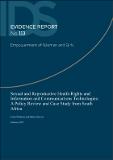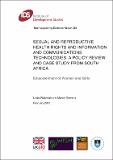| dc.contributor.author | Waldman, Linda | |
| dc.contributor.author | Stevens, Marion | |
| dc.coverage.spatial | South Africa | en |
| dc.date.accessioned | 2015-02-17T09:37:03Z | |
| dc.date.available | 2015-02-17T09:37:03Z | |
| dc.date.issued | 2015-02 | |
| dc.identifier.citation | Waldman, L. and Stevens, M. (2015) Sexual and Reproductive Health Rights and Information and Communications Technologies: A Policy Review and Case Study from South Africa, IDS Evidence Report 113, Brighton: IDS | en |
| dc.identifier.uri | https://opendocs.ids.ac.uk/opendocs/handle/20.500.12413/5787 | |
| dc.description.abstract | This report explores the intersection between sexual and reproductive health (SRH) and
technological means of enhancing health. South Africa has a high teenage pregnancy rate. Almost a third of its girl teenagers report having been pregnant. The drivers of teenage pregnancy include uneven gender relations, poor access to health services and a lack of knowledge about sexual reproduction, contraception and poverty. Poverty and place of residence also affect pregnancy and health outcomes. Women and girls living in low-income residential areas have little or no access to comprehensive sexual and reproductive health services, including sexual, reproductive and maternal health. Women and girls located in rural, peri-urban and informal settlement contexts also experience technology deficits, including low levels of mobile phone ownership, poor network coverage, weak satellite signals and insufficient bandwidth. At present, very little research explores health within peri-urban contexts and the interconnections between poverty, place and health. At the same time, e- and m-health, and the information and communications technologies (ICT) that they rely on are frequently seen as a panacea to struggling health systems and as a means of meeting the health needs of women and girls in hard-to-reach places. Yet many complex factors are required for a successful m-health intervention. These include appropriate policy recognition from both the Department of Health and the Department of Communications; cooperation between the government and the private sector to bring together professional expertise (in health and technology); financial resources; awareness of women’s and girls’ sexual and reproductive health needs and rights; planning and provision of health information; consideration of ethical information and privacy; and awareness of the potential
for such systems to generate savings and/or additional revenue. Using ICT (particularly
mobile phones) to address the sexual and reproductive health needs of women and girls in hard-to-reach places is in its infancy. However, ICT and health offer enormous business
potential and many mobile phone companies are exploring possible business models. This
creates potential for the government and commercial companies to cooperate and develop
new initiatives. This report is an exploration of this complex and emerging landscape which looks at relevant policies and current practice, asking: how are poor women’s and girls’ needs in rural and peri-urban conditions catered for through technological innovation in health? | en |
| dc.description.sponsorship | UK Department for International Development | en |
| dc.language.iso | en | en |
| dc.publisher | IDS | en |
| dc.relation.ispartofseries | IDS Evidence Report;113 | |
| dc.relation.ispartofseries | IDS Evidence Report Brief;113 | |
| dc.rights.uri | http://creativecommons.org/licenses/by/3.0/ | en |
| dc.subject | Gender | en |
| dc.subject | Health | en |
| dc.subject | Rights | en |
| dc.subject | Technology | en |
| dc.title | Sexual and Reproductive Health Rights and Information and Communications Technologies: A Policy Review and Case Study from South Africa | en |
| dc.type | IDS Evidence Report | en |
| dc.rights.holder | IDS | en |
| dc.identifier.ag | OT/11009/3/2/2/88 | |
| dc.identifier.ag | OT/11009/3/2/2/89 | |



